Try our favorite, clean protein powder: See our top pick →
Try our favorite, clean protein powder: See our top pick →
This post contains links through which we may earn a small commission should you make a purchase from a brand. This in no way affects our ability to objectively critique the products and brands we review.
Evidence Based Research To fulfill our commitment to bringing our audience accurate and insightful content, our expert writers and medical reviewers rely on carefully curated research.
Read Our Editorial Policy
With its plethora of oily fish, lush olive trees, and abundant vegetables, the Mediterranean region is acclaimed for its nutritious and delicious cuisine.
Encompassing the foods of Italy, Spain, Greece, Morocco, Turkey, and more, the so-called “Mediterranean diet” is now a renowned style of eating that benefits health and longevity.
While coming up with Mediterranean-style lunches and dinners is an easier feat, many people need help with morning time, wondering what exactly Mediterranean diet breakfasts might entail.
With these Mediterranean diet breakfast ideas containing fresh veggies, fruit, yogurt, tomatoes, feta cheese, and ancient grains, you can feel good knowing that your morning meal is both healthy and delicious.
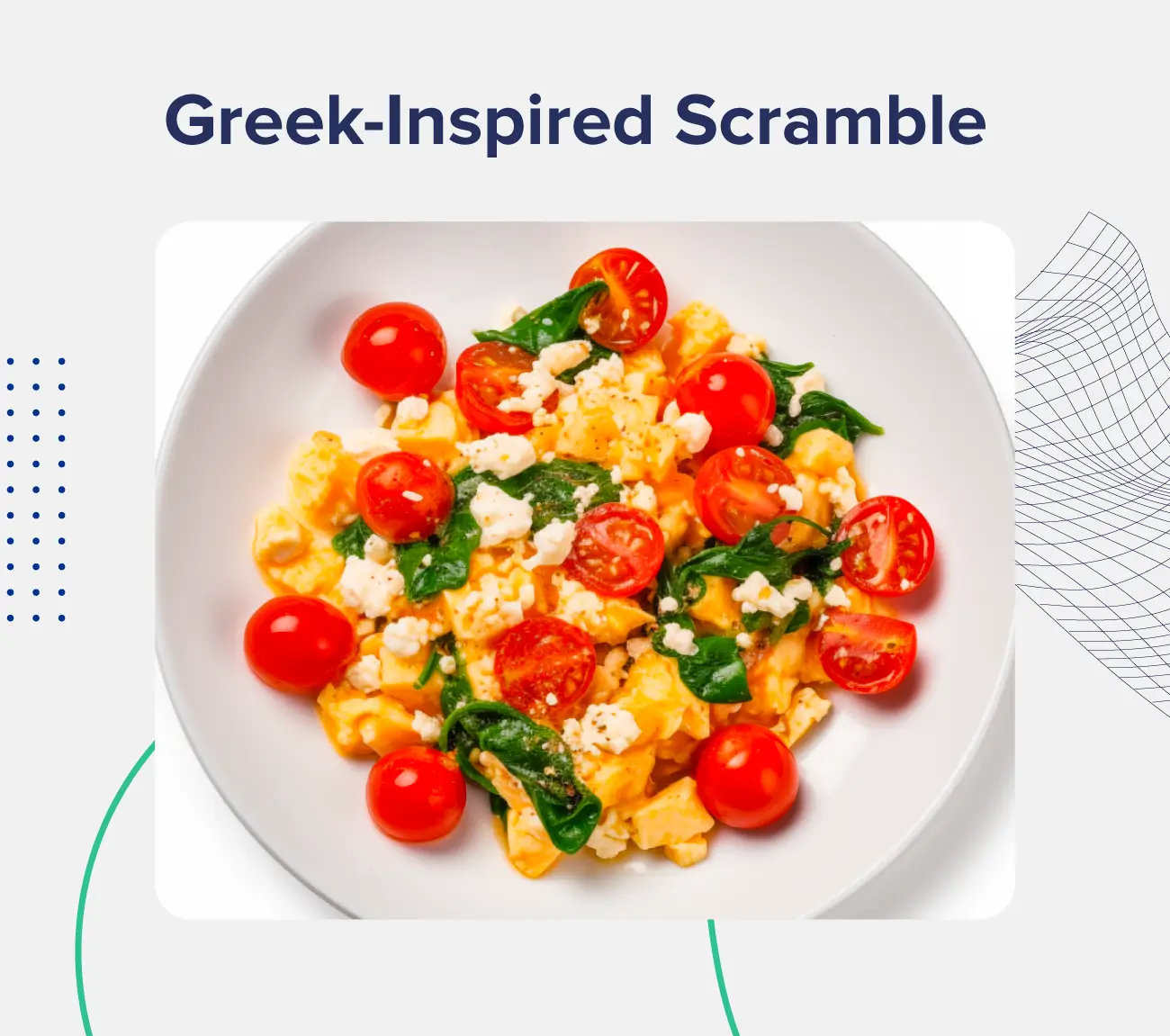
Some of the prominent foods that come to mind when you hear “Greek” include feta cheese, olive oil, and tomatoes—and this 10-minute scramble has all three.
In this Mediterranean breakfast recipe, you can customize the vegetables and herbs you prefer, but adding red onion, tomatoes, spinach, and artichoke hearts makes it distinctly Greek.
We also love using feta for a salty and slightly tangy bite and a sprinkling of parsley on top for bright freshness and visual appeal.
Servings: 1
Ingredients:
Directions:
Nutrition Facts: (Per serving)
Calories: 370
Fat: 27g
Total Carbs: 12g
Fiber: 5g
Protein: 21g

A dish that is said to have originated in Tunisia, Israel, or Morocco, shakshuka is a one-pan meal with poached eggs in a chunky tomato sauce.
Although fresh tomatoes are best, they aren’t always in season—in that case, use high-quality canned whole tomatoes with their juices included, like San Marzano.
The sauce typically includes onions, bell peppers, garlic, and seasonings like cumin, paprika, and red pepper flakes.
After making the sauce, nestle the cracked eggs in the sauce and gently poach them in the simmering sauce until they are cooked to your liking.
Shakshuka is a low-carb and healthy Mediterranean breakfast—but many people also eat this savory dish for lunch or dinner.
Servings: 6
Ingredients:
Directions:
Nutrition Facts: (Per serving)
Calories: 150
Fat: 9g
Total Carbs: 10g
Fiber: 3g
Protein: 7g

Although avocados are native to Mexico and Central America, their nutritional profile fits the Mediterranean-style bill—and avocado toast is the perfect vehicle to eat them.
Like olives, avocados are rich in monounsaturated fat, a type commonly consumed in Mediterranean cuisines that have heart-healthy benefits.
Topping a large slice of crusty sourdough bread with sliced or mashed avocado, red onions, chunks of feta, diced cherry tomatoes, and a generous sprinkle of dill make this avocado toast a perfect millennial-Mediterranean breakfast—and it takes mere minutes to prepare!
Servings: 1
Ingredients:
Directions:
Nutrition Facts: (Per serving)
Calories: 375
Fat: 25g
Total Carbs: 31g
Fiber: 9g
Protein: 9g
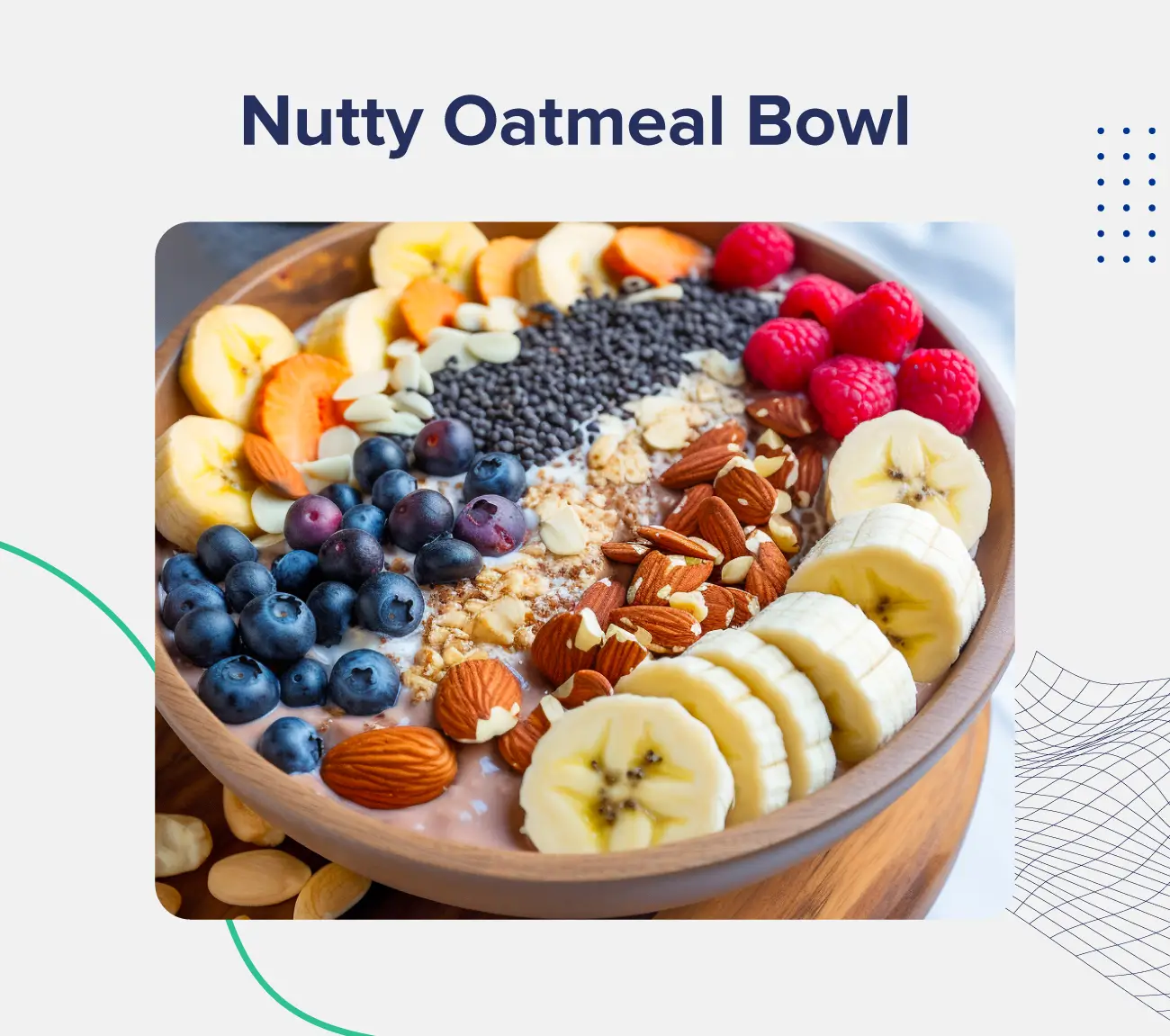
Oats are a whole grain, which is encouraged on the Mediterranean diet—especially when you choose less processed versions like steel-cut oats.
The Mediterranean style of eating is low in refined carbohydrates that are ultra-processed, which would include most cereals and instant oatmeal.
Rather, steel-cut oatmeal is higher in fiber, has a denser texture and nuttier flavor, and has less of an impact on blood sugar than instant oatmeal.
We also included a variety of nuts and some distinctly Mediterranean fruits—figs and apricots—but feel free to use any fruit you prefer, as all are allowed on the Mediterranean diet.
Servings: 4
Ingredients:
Directions:
Nutrition Facts: (Per serving)
Calories: 400
Fat: 21g
Total Carbs: 44g
Fiber: 10g
Protein: 10g

Yogurt on toast may sound like an odd combination—but we’re not talking about thin and runny yogurt here; we’re using traditional Greek yogurt for this Mediterranean diet breakfast.
Greek and regular yogurt are made from the same ingredients, but Greek yogurt has the liquid strained out of it, resulting in a more concentrated and thicker yogurt.
For this reason, Greek-style yogurt is higher in protein and calories than regular yogurt, typically containing 18 to 20 grams of protein per serving.
While you can use raw tomatoes if you’re in a time crunch, this toast is much more delicious if you quickly blister them in a pan—simply heat olive oil in a pan and cook cherry tomatoes until they start to burst.
Servings: 1
Ingredients:
Directions:
Nutrition Facts: (Per serving)
Calories: 300
Fat: 15g
Total Carbs: 26g
Fiber: 2g
Protein: 14g

Mint is native to the Mediterranean, making it the perfect herb to include in this refreshing berry smoothie.
Spearmint is the type most commonly sold in grocery stores (no, it’s not just for gum), and it’s known for its ability to relieve indigestion and freshen breath.
Berries, citrus, and mint go particularly well together, so we included strawberries, raspberries, and lemon in this smoothie.
Like always, feel free to customize this recipe to suit your liking. We added extra protein (with protein powder) to make this a more satiating breakfast, but you can omit it if this smoothie is more of a snack.
Servings: 1
Ingredients:
Directions:
Nutrition Facts: (Per serving)
Calories: 240
Fat: 5g
Total Carbs: 16g
Fiber: 3g
Protein: 32g
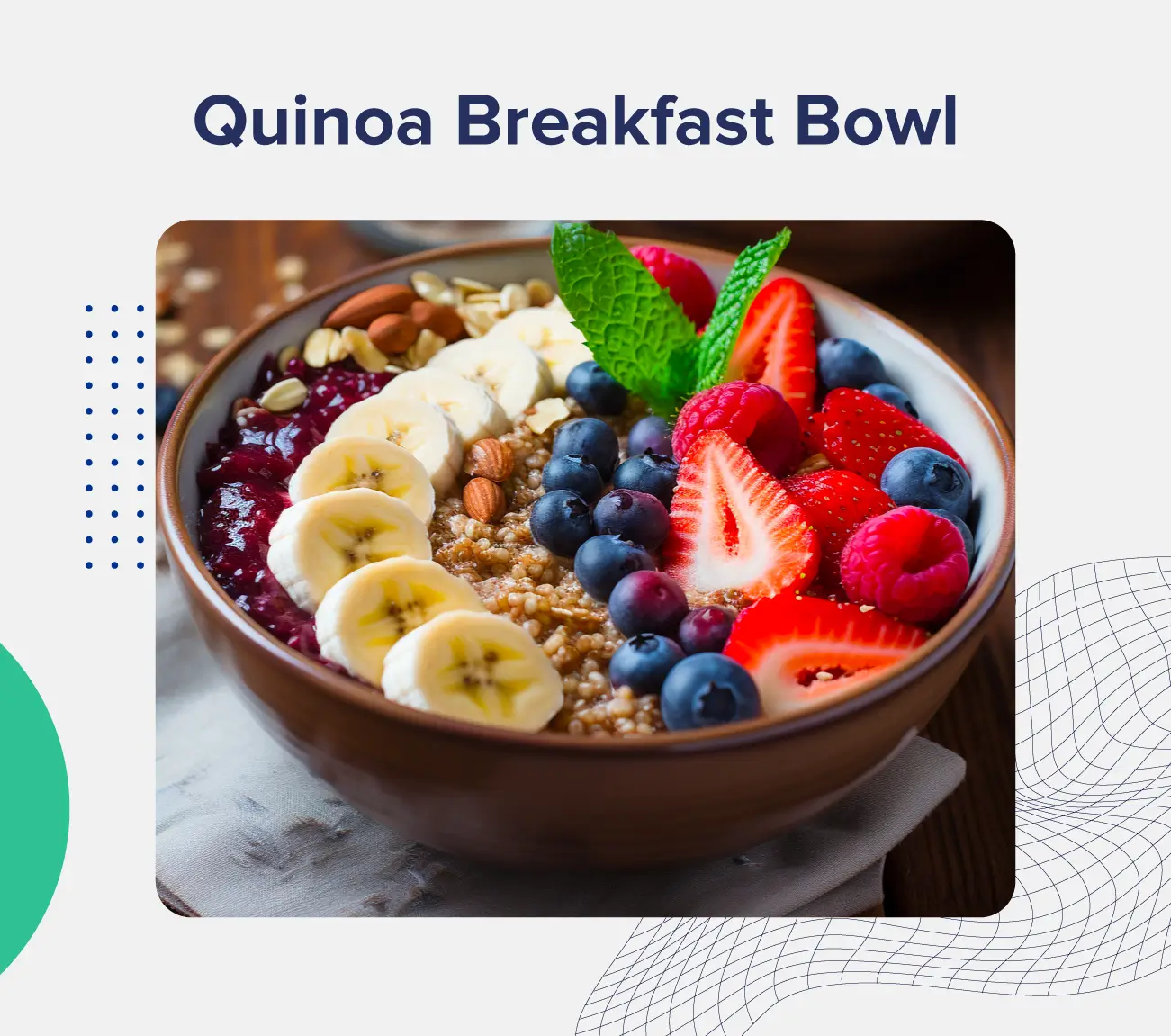
While oats are typically the shining star of hot breakfast bowls, quinoa makes a great substitute.
Although quinoa originates from South America, it is a commonly consumed grain on the Mediterranean diet, as it’s a whole and unprocessed grain with high fiber and protein content.
This is another customizable meal—feel free to add berries, diced apples, sliced bananas, coconut flakes, nuts, or seeds on top of this breakfast bowl.
You can also eat it immediately like you would a bowl of hot oatmeal, or cool it in the fridge, pour additional nut milk on top, and treat it like a bowl of cold cereal or overnight oats.
Servings: 2
Ingredients:
Directions:
Nutrition Facts: (Per serving, with ½ cup fruit topping)
Calories: 380
Fat: 5g
Carbs: 65g
Fiber: 8g
Protein: 16g
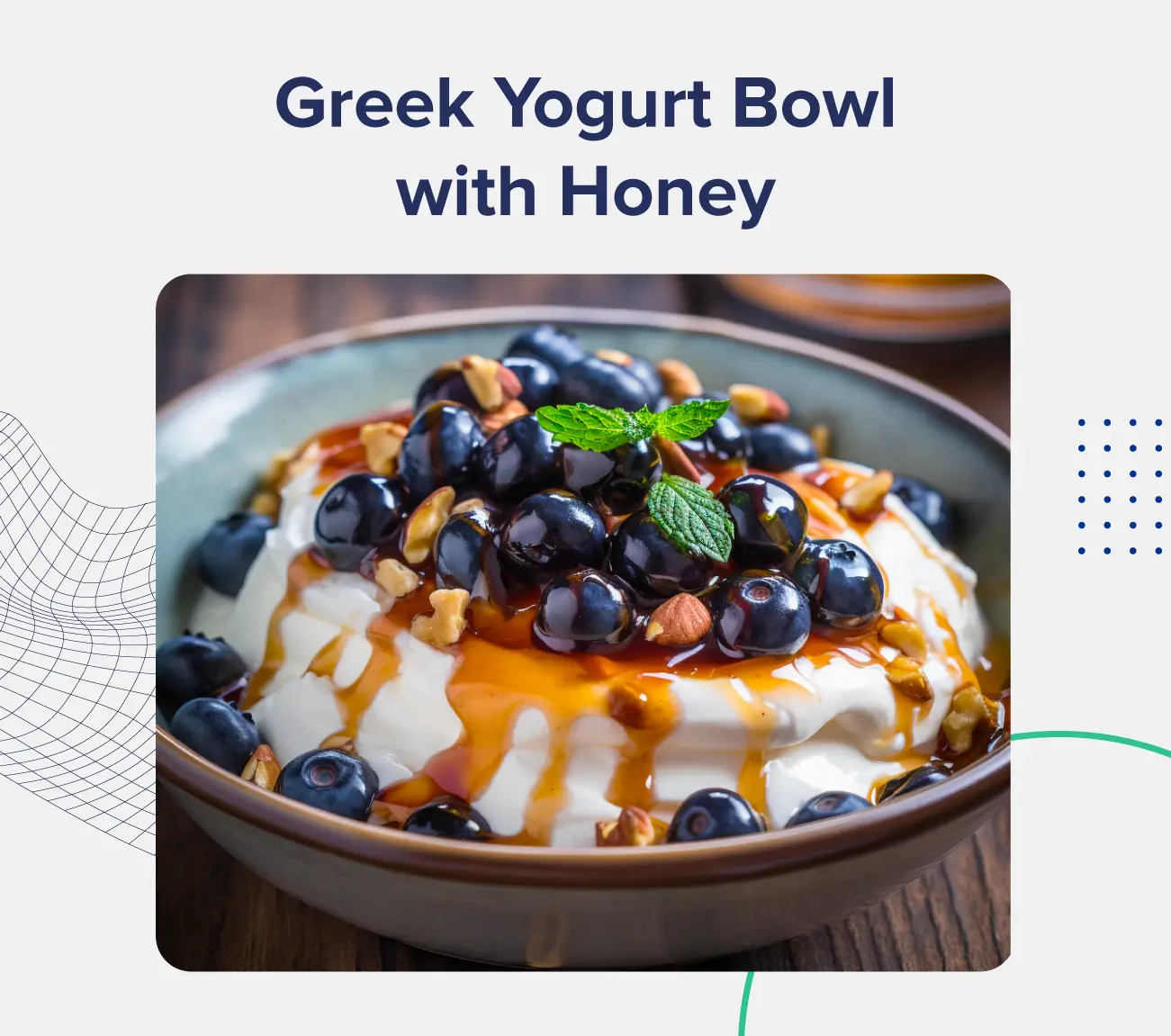
A very simple Mediterranean diet breakfast, this yogurt bowl takes less than a minute to prepare and can keep you full for hours.
Greek yogurt contains 3 grams of protein per ounce, so we’d recommend consuming 8-10 ounces if this is the only thing you’re eating this morning.
Most single-serve yogurt containers are 5 to 6 ounces, so purchasing a larger tub can be beneficial here.
Having 25 to 30 grams of protein for breakfast can set you up for a healthy day, increasing satiety and reducing your calorie intake at subsequent meals.
Servings: 1
Ingredients:
Directions:
Nutrition Facts: (Per serving)
Calories: 400
Fat: 16g
Total Carbs: 35g
Fiber: 1g
Protein: 30g
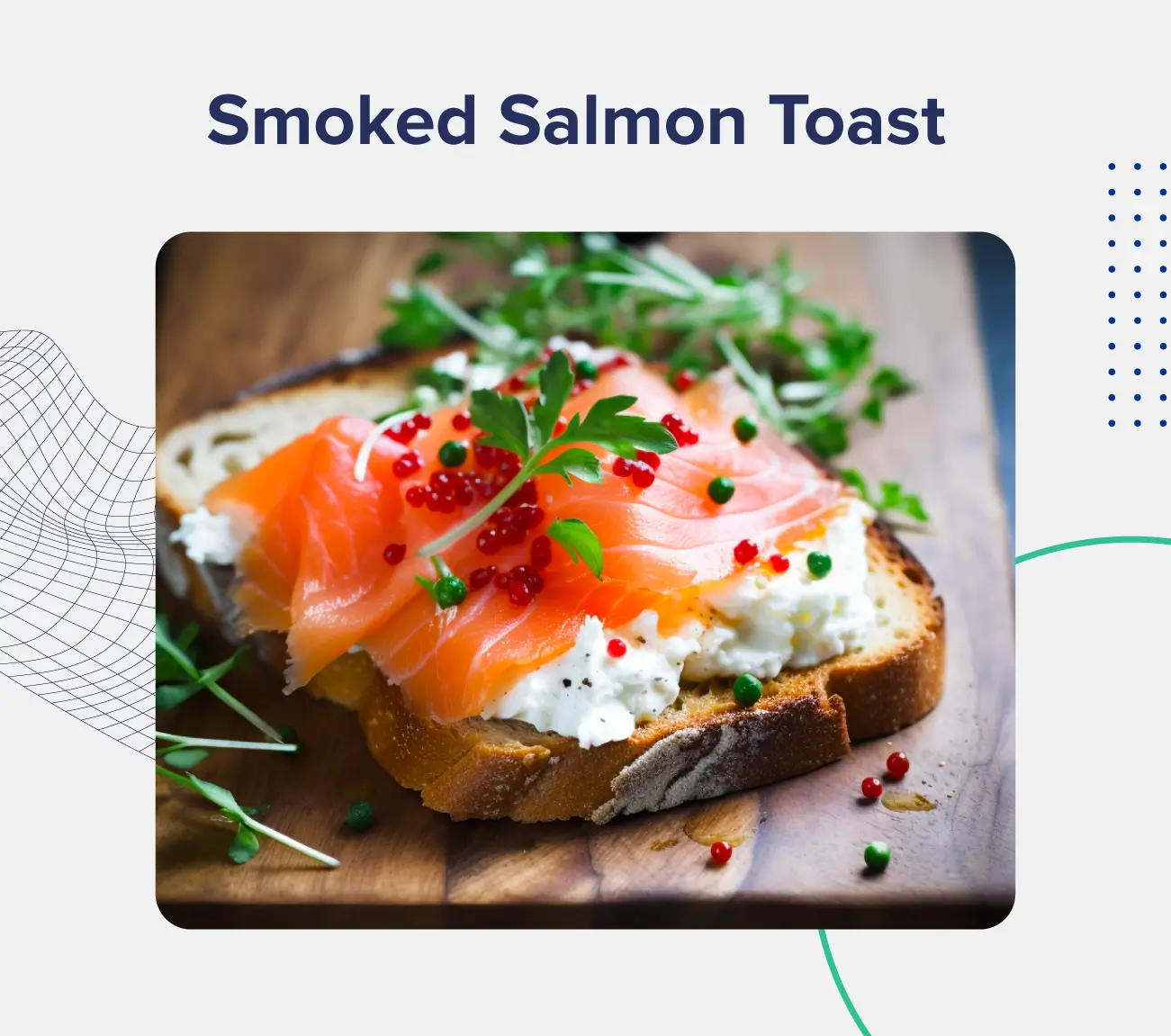
Seafood is a staple of the Mediterranean diet—especially fish high in healthy fats, like salmon.
While most people don’t love fish at their morning meal, smoked salmon is a notable exception—when paired with cream cheese and dill, you’ve got a delicious Mediterranean breakfast.
A more common base for smoked salmon and cream cheese is a bagel, but we used a thick slice of rye bread in this easy breakfast to increase the fiber and reduce overall carbohydrates.
Servings: 1
Ingredients:
Directions:
Nutrition Facts: (Per serving)
Calories: 325
Fat: 13g
Total Carbs: 24g
Fiber: 3g
Protein: 26g
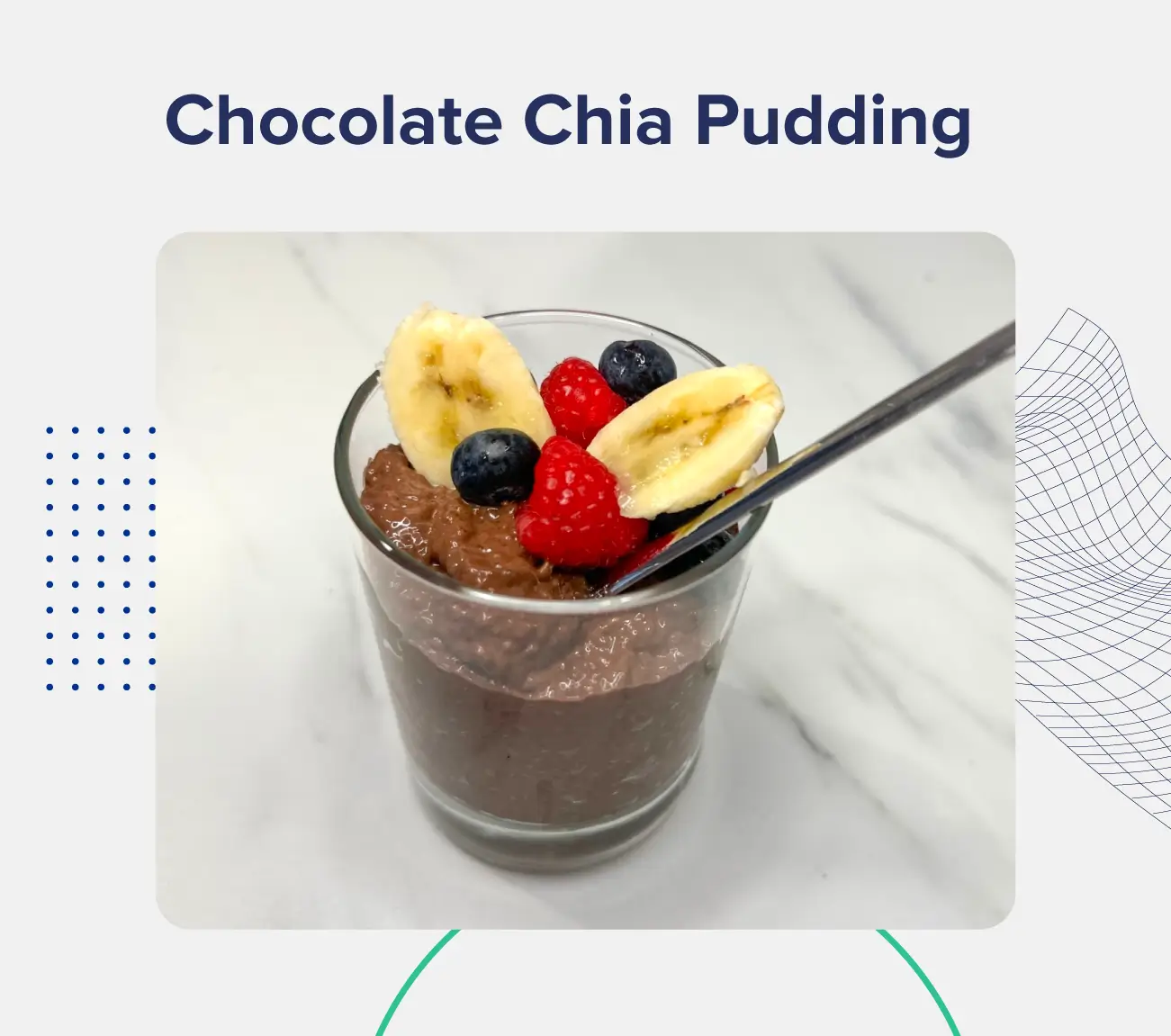
As one of those perfect recipes that can be eaten as either a healthy breakfast or dessert, this chocolate chia pudding checks all of the boxes.
Chia seeds originate from Central America, where they were a staple in the Aztec diet, but people in the Mediterranean now also enjoy these nutrient-packed seeds.
With fiber-rich chia seeds and no refined sugar, this vegan and gluten-free recipe tastes like chocolate pudding but packs a nutritional punch.
We also added an optional scoop of vanilla protein powder to up the satiety factor, but feel free to leave it out if you don’t have that handy.
Chocolate Chia Pudding Recipe:
Servings: 1
Ingredients:
Directions:
Nutrition Facts: (Per serving)
Calories: 400
Fat: 13g
Carbs: 47g
Fiber: 10g
Protein: 34g
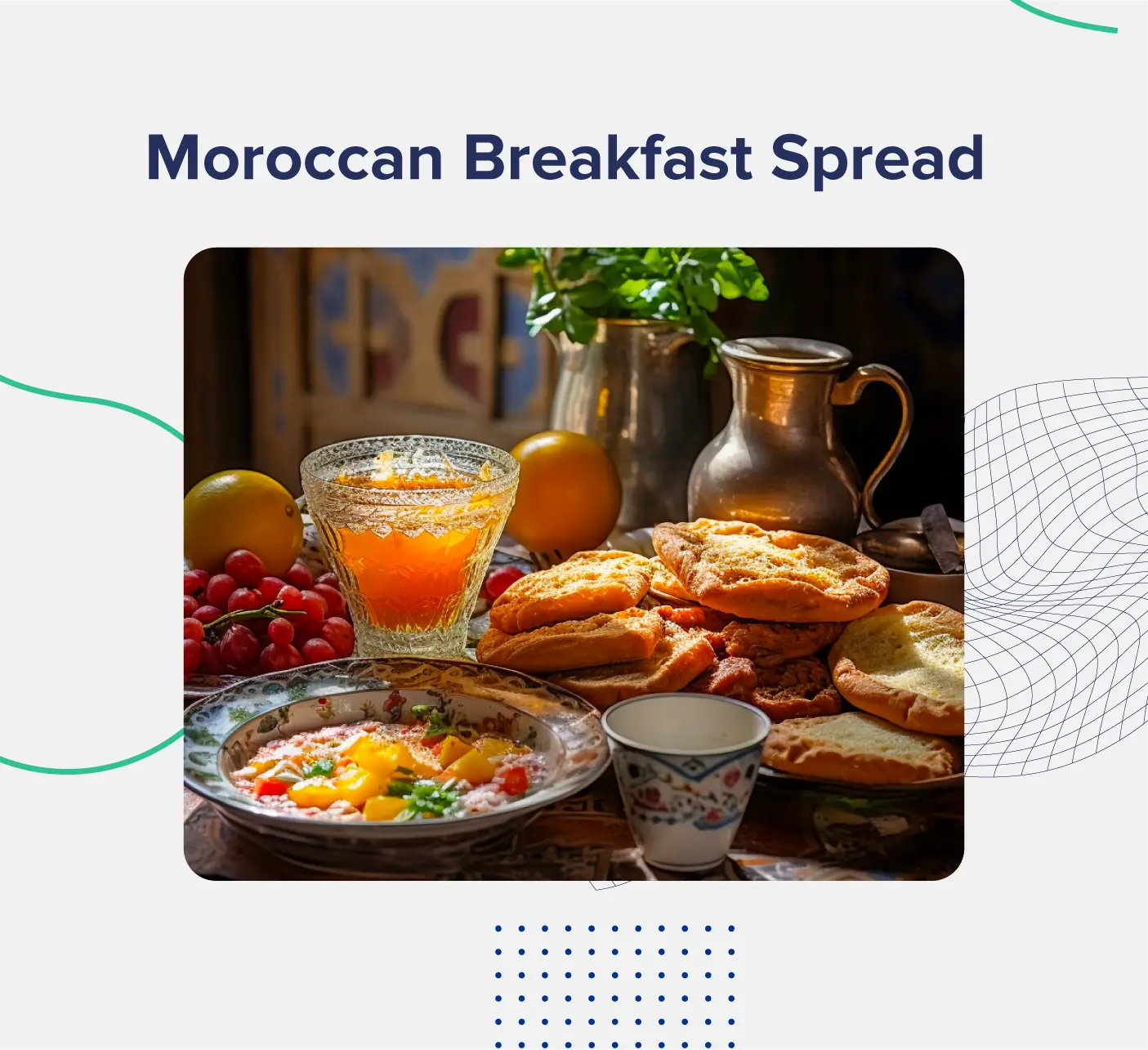
Although Greece is the most commonly referenced cuisine in the Mediterranean diet, Morocco in North Africa also provides a heavy influence on this style of eating.
A typical Moroccan breakfast might include crusty freshly baked bread called khobz, fried eggs, goat cheese, olives, and amlou—a pureed dip made of toasted almonds, argan oil, and honey (similar to peanut or almond butter in texture).
And it wouldn’t be a Moroccan morning without classic Moroccan mint tea—buy it here or make it with gunpowder green tea, spearmint leaves, and sugar.
As this breakfast spread contains many recipes in one, we won’t include directions on how to make everything—but check out these recipes for whole grain khobz and amlou if you want to make them.
Servings: 2
Ingredients:
Directions:
Nutrition Facts: (Based on 2 eggs, 1 slice of bread, 2 Tbsp amlou, ⅛ cup olives, and ¼ cup goat cheese)
Calories: 530
Fat: 37g
Total Carbs: 20g
Fiber: 4g
Protein: 31g
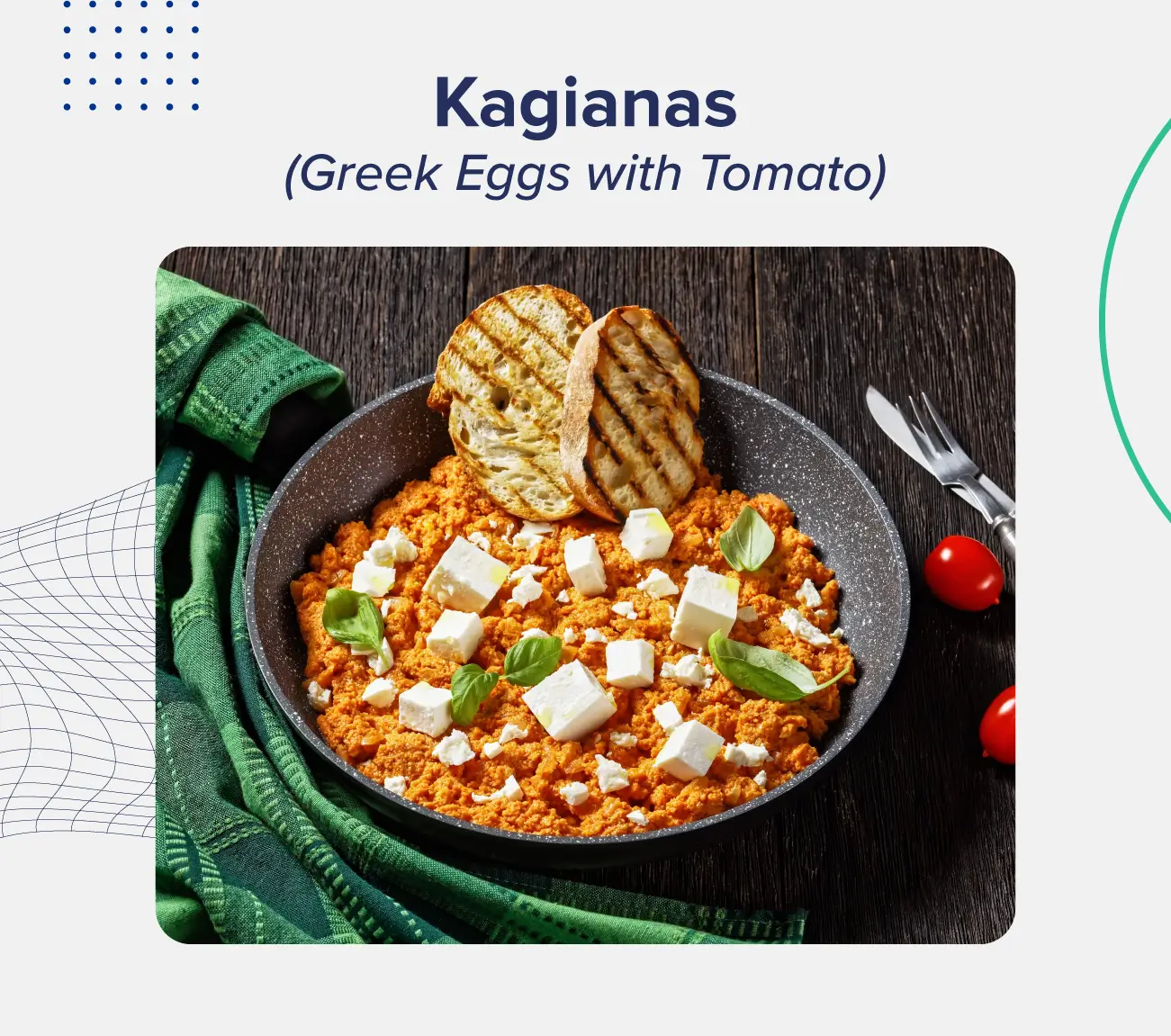
Kagianas—also known as strapatsada—is a classic Greek version of scrambled eggs, made with loads of fresh tomato and feta cheese.
This dish is very heavy on the tomatoes, which should be grated or very finely chopped, making the final product almost entirely red in color.
Alternatively, you can pulse the tomatoes in a food processor for an even finer chop.
While you can use canned tomatoes during the winter months, fresh and in-season tomatoes will always taste best.
Servings: 4
Ingredients:
Directions:
Nutrition Facts: (Per serving)
Calories: 250
Fat: 18g
Total Carbs: 5g
Fiber: 1g
Protein: 16g
Although each country bordering the Mediterranean Sea consumes different varieties and styles of food, there are a few key components that make up Mediterranean cuisine.
The basis of Mediterranean cooking is an abundance of fresh produce and plant-based proteins, including beans and whole grains.
Although Mediterranean cuisines are not vegetarian, animal products typically take a back seat to plant-based foods—except when it comes to fish and seafood, which are highly encouraged and commonly consumed.
As the Mediterranean diet is low in meat, the diet provides plenty of unsaturated fats from nuts, seeds, olives, and oily fish while keeping saturated fat intake low.
Additionally, the abundance of fresh fruits, vegetables, herbs, and spices provides high amounts of antioxidants and plant-based compounds called polyphenols that benefit health.
This style of eating also promotes consuming whole, unprocessed foods rather than ultra-processed foods, like crackers, chips, white bread, or white pasta.
The main foods to eat on the Mediterranean diet include:
Some foods are not eliminated but are encouraged to be consumed in moderation, including:
In addition to those healthy foods to consume, there are some foods to avoid when eating a Mediterranean diet, including:
Although meats like bacon and sausage are not recommended on the Mediterranean diet, there are many other options for a Mediterranean breakfast.
Common Mediterranean breakfast foods include whole, less-processed grains (like oats, whole wheat bread, or quinoa), eggs, yogurt, vegetables, avocado, nuts, seeds, and fruit.
Some Mediterranean breakfast recipes include egg scrambles, avocado toast, smoothies, yogurt bowls, and oatmeal.
Yes, you can eat rolled oats or steel-cut oats on the Mediterranean diet, as they are lightly processed whole grains. Oats are commonly consumed in Mediterranean diet breakfasts (either hot or as overnight oats), as they are filling and high in fiber. However, instant oatmeal (especially sweetened types) is not typically recommended on the Mediterranean diet.
Higher-fiber, whole-grain bread is best for the Mediterranean diet. This may include freshly baked sourdough, whole grain toast, or rye bread.
Yes, you can eat eggs on the Mediterranean diet. However, they are likely not consumed every day.
Mediterranean diet foods include fruits, vegetables, herbs, spices, lean proteins, beans, legumes, seafood, cultured dairy, monounsaturated fats (like olives and avocado), nuts, and seeds.
Subscribe now and never miss anything about the topics important to you and your health.